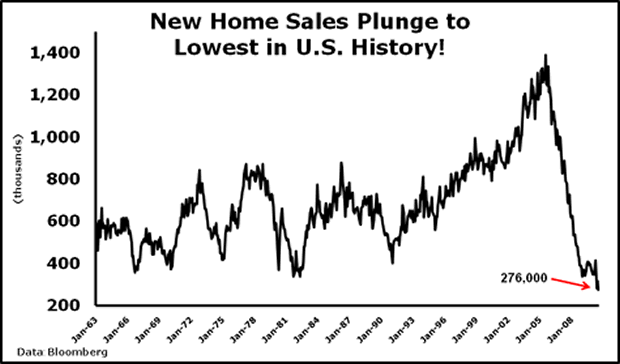Results 1 to 1 of 1
Thread Information
Users Browsing this Thread
There are currently 1 users browsing this thread. (0 members and 1 guests)
Threaded View
-
09-03-2010, 06:53 PM #1Senior Member


- Join Date
- May 2007
- Location
- South West Florida (Behind friendly lines but still in Occupied Territory)
- Posts
- 117,696
Double-Dip Recession Deepens as U.S. Housing Market Collapse
Double-Dip Recession Deepens as U.S. Housing Market Collapses
Housing-Market / US Housing
Sep 03, 2010 - 09:07 AM
By: Mike_Larson
The Double-Dip recession Iâve been predicting for some time is deepening. And nowhere is the emergence of this powerful economic force more clear than in the housing market.
All the fresh economic data confirms that home sales are weakening ⦠home inventories are rising ⦠and home price pressure is building.
Meanwhile, weâre seeing a fresh rise in early-stage mortgage delinquencies after a multi-quarter respite. Credit demand is contracting for real estate and other loans. And bank failures are rising fast.
This canât be prevented. Neither the Obama administration nor Congress nor the Federal Reserve can fire some magic bullet at the problem to kill it. So as an investor, you can only do one thing: Prepare!
Housing Dip Deepens As Artificial Support Wanes
Last week while I was on vacation, we got a rash of fresh data on housing â none of it pretty. Just consider â¦
New home sales plunged 12 percent in July to a seasonally adjusted annual rate of only 276,000. Thatâs the lowest level since the Census Bureau began tracking these figures in 1963.

The median price of a new home slumped 4.9 percent from a year ago to $204,000. Thatâs the lowest level since 2003.
Existing home sales collapsed 27 percent in July to an annual rate of 3.83 million. That was twice as large a decline as economists expected.
Keep in mind that number includes not just single-family home sales, but also sales of condominiums and co-ops. If you use the single-family only figures, which go back decades, you see that sales havenât been this weak since 1995.
The combination of falling sales and rising for-sale inventory is going to torpedo pricing. Heck, we now have 11.9 months of inventory on the market in single family homes, assuming the current sales pace were to hold constant. Thatâs the worst reading since 1983.
Worse, more and more supply keeps being dumped on the market by banks and other owners of repossessed homes. The Home Affordable Modification Program, or HAMP, was supposed to prevent that from happening. But it has only provided 340,000 permanent mortgage modifications. Thatâs far short of the four million modifications the Obama administration laid out as a goal when it rolled the thing out more than a year ago.
At the same time, the Mortgage Bankers Association just said that the 30-day late payment rate rose to 3.51 percent of all home loans in the second quarter. Thatâs the first gain in early-stage delinquencies in more than a year, and a leading indicator of rising future foreclosures.
Look, weâve already seen 118 banks fail so far in 2010. Plus, the FDIC just revealed that its âproblem listâJoin our efforts to Secure America's Borders and End Illegal Immigration by Joining ALIPAC's E-Mail Alerts network (CLICK HERE)


 LinkBack URL
LinkBack URL About LinkBacks
About LinkBacks






 Reply With Quote
Reply With Quote

Migrants Breach Fortified Border Barrier, March Through Texas...
05-16-2024, 08:20 PM in illegal immigration News Stories & Reports